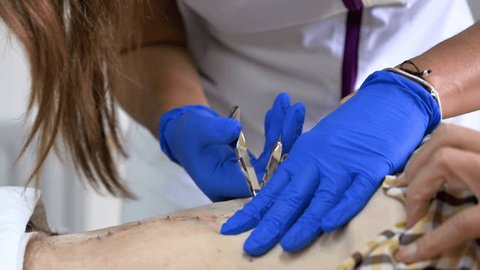Before attempting Suture Removal at Home in Dubai(إزالة الغرز في المنزل في دبي), it is essential to understand the types of sutures used in wound closure. Not all stitches are created equal, and removing the wrong type or doing it too early can cause complications. By recognizing the different suture materials and their functions, individuals can make informed decisions and avoid unnecessary health risks.
Absorbable Sutures:
Absorbable sutures are designed to break down naturally in the body over time. They are commonly used for internal wounds or deep tissues where manual removal isn’t practical. These sutures are made from materials like polyglycolic acid or catgut, and they dissolve through enzymatic or hydrolytic processes. Since they don’t require removal, they are not relevant for home removal practices and should be left to resolve on their own.
Non-Absorbable Sutures:
Unlike absorbable types, non-absorbable sutures must be manually removed once the wound has sufficiently healed. These are made from materials such as nylon, polypropylene, or silk. They are often used on external skin surfaces where long-term strength and durability are needed. For Suture Removal at Home in Dubai, identifying these stitches is critical, as only non-absorbable types are candidates for safe removal outside a clinical setting.
Monofilament Sutures:
Monofilament sutures are made from a single strand of material, offering low tissue drag and minimal infection risk. Their smooth surface makes them easier to pull through tissue, which can also make removal easier. However, they can be more difficult to tie securely and may slip if not handled properly. When removing these at home, extra care must be taken to ensure all knots are located and cleanly cut before pulling.
Multifilament Sutures:
Made from multiple braided strands, multifilament sutures offer excellent knot security and flexibility. However, their braided nature can harbor bacteria if not properly maintained. This makes them less ideal for home removal unless the wound is entirely clean and healed. Proper hygiene is especially important when dealing with these sutures to avoid post-removal infections.
Barbed Sutures:
Barbed sutures are unique in that they do not require knots to stay in place. Small barbs along the strand grip the tissue and provide tension evenly. While beneficial in surgical environments, these sutures are not commonly used for wounds that would require at-home removal. Attempting to remove barbed sutures without professional help can damage tissue and cause bleeding, so they are best left to medical professionals.
Identifying Your Suture Type:
Understanding what type of suture has been used in your wound starts with checking your medical discharge papers or consulting the healthcare provider who applied them. Sometimes, sutures can appear similar to the untrained eye, but their material and structure play a huge role in how and when they should be removed. For anyone considering Suture Removal at Home (إزالة الغرز في المنزل ), correctly identifying suture type is the first step to safe and effective removal.
Risks of Removing the Wrong Type:
Removing absorbable sutures or specialty sutures like barbed types too early or incorrectly can cause the wound to reopen or introduce bacteria. In some cases, remaining fragments of suture material can trigger inflammation or infection. It’s also possible to experience pain or bleeding if removal is rushed or improperly performed. Recognizing these risks highlights the importance of education before proceeding with any at-home procedure.
Final Thoughts:
Before considering Suture Removal at Home in Dubai, you must first understand the types of sutures involved. Knowing whether they are absorbable, non-absorbable, monofilament, or multifilament helps ensure the removal is appropriate and safe. While home removal may be feasible for straightforward cases, complex or unfamiliar suture types always warrant professional attention to avoid health setbacks. Prioritize knowledge and caution when managing your recovery at home.
 :
https://www.royalclinicdubai.com/ar-ae
:
https://www.royalclinicdubai.com/ar-ae

